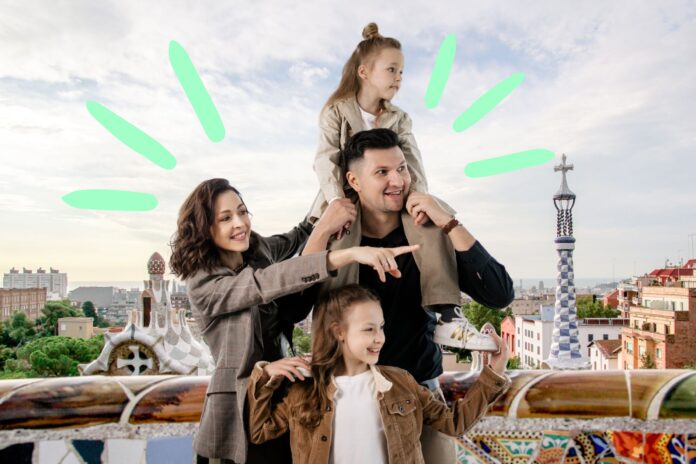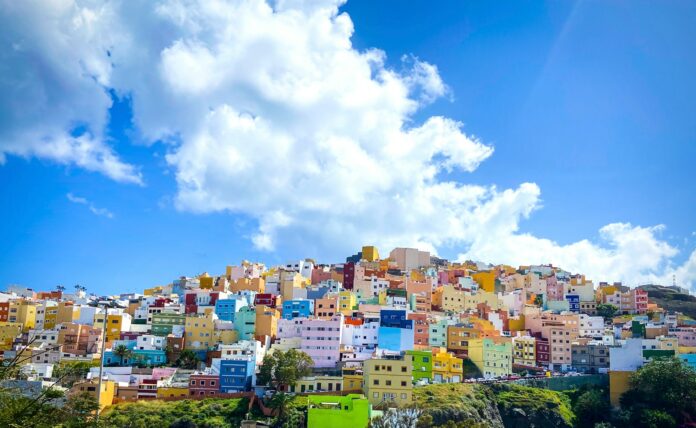Imagine a place where time seems to slow down, where nature dominates in all its raw, untamed beauty. Sitting halfway between Scotland and Iceland in the wild North Atlantic is a mystical archipelago of islands, islets, and skerries that few travellers have discovered.
Welcome to the Faroe Islands – perhaps Europe’s most dramatic and bewitching hidden gem. The name Faroe (pronounced a bit like furr-ee-yar) comes from the Old Norse word ‘færeyjar’ meaning ‘sheep islands’, and it’s a fitting description. These 18 windswept volcanic isles are home to approximately 70,000 sheep – significantly outnumbering the human population of less than 50,000. Here, ancient traditions persist, and modern life adapts to nature’s whims rather than the other way around.
There has been a tourism boom to these North Atlantic islands, and it’s easy to see why – almost every spot in the Faroes is extraordinary and completely unforgettable. The landscape is a photographer’s dream: dramatic fjords cutting deeply into emerald-green land, towering sea stacks rising majestically from churning seas, thundering waterfalls cascading over ancient basalt cliffs, serene lagoons reflecting moody skies, charming turf-roofed churches standing as they have for centuries, mysterious black-sand beaches stretching into the mist, thrilling hiking trails traversing vertigo-inducing ridges, and protected puffin colonies teeming with these charismatic seabirds.

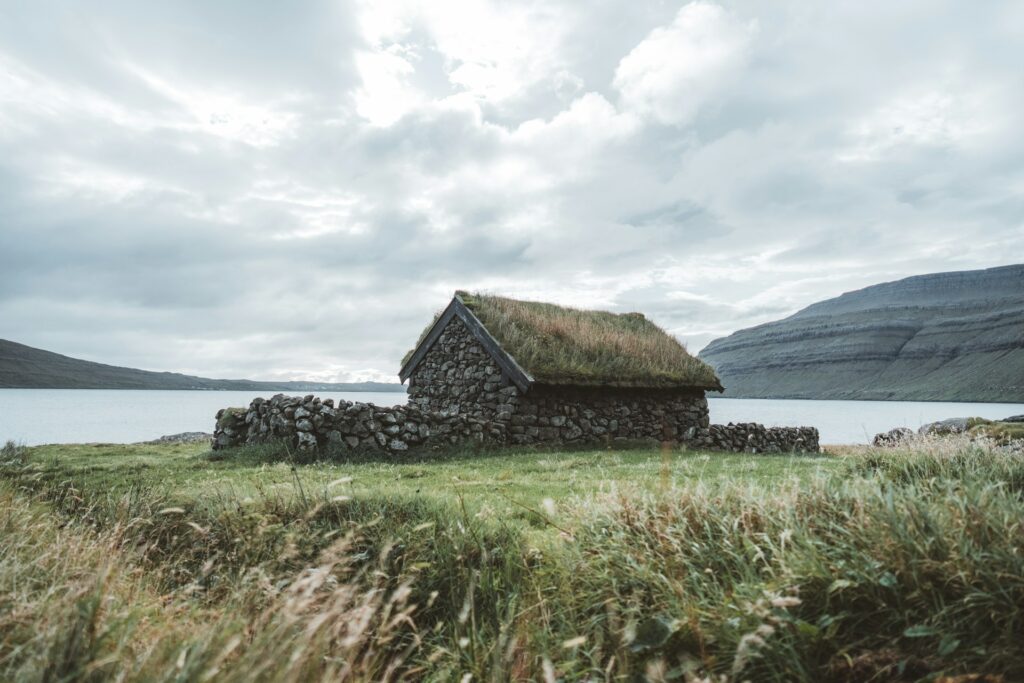
While the Faroe Islands has been regarded as self-governing since 1948, it’s not completely independent. Denmark has a hand in its ruling including defence, policing and foreign affairs. That said, and although technically a Danish constituent country, it remains very much its own place with a distinct culture, language, cuisine, and identity shaped by centuries of isolation and the powerful forces of nature.
It’s often likened to Iceland but without the crowds – a pristine, untouched wilderness waiting to be explored by those seeking genuine adventure off the beaten path. If you’re planning on visiting the Faroe Islands for the first time, here are some things you need to know before your trip.
How To Get There
The most straightforward way to reach the Faroe Islands is by air. Vágar Airport serves as the main gateway, with Atlantic Airways (the national carrier) offering regular flights from Copenhagen, Edinburgh, and other European cities. Icelandair has also begun direct flights from Reykjavik to Vágar five to six times weekly, making it easier than ever to include the Faroes in your Nordic itinerary.
For the more adventurous traveller, the Smyril Line ferry connects Denmark to the Faroe Islands, offering a scenic (albeit longer) journey across the North Atlantic.
Best Time of Year To Travel
While rain is expected somewhere in the islands 300 days a year, June is widely considered the best time to visit. Temperatures remain relatively mild in the Faroes during summer, and daylight hours are at their longest during this month – perfect for maximising your sightseeing opportunities with nearly 20 hours of daylight.
That said, be prepared: the islands can be really, really wild and windy, and tackling the weather can be one of the greatest difficulties. Even in summer, temperatures rarely exceed 15°C (59°F), and rain can appear seemingly out of nowhere. That saying that “if you don’t like the weather, wait five minutes” rings particularly true here.
In the summer months, the islands host one of the most popular festivals in Europe. Established in 2002, G! runs almost every year, whatever the weather. Held annually at the seaside village of Gøta on Eysturoy in mid or late July, it’s one of the world’s most remote festivals.
Visiting in winter offers a dramatically different but equally compelling experience. From November through February, the Faroes transform into a moody, atmospheric realm of dark skies, powerful storms, and breathtaking natural drama. Daylight hours are limited (sometimes just 5-6 hours), creating a twilight quality that photographers cherish for its soft, ethereal light. Snow is relatively rare at sea level due to the Gulf Stream’s influence, but it often dusts the mountain peaks, creating stark contrasts against the dark winter skies.
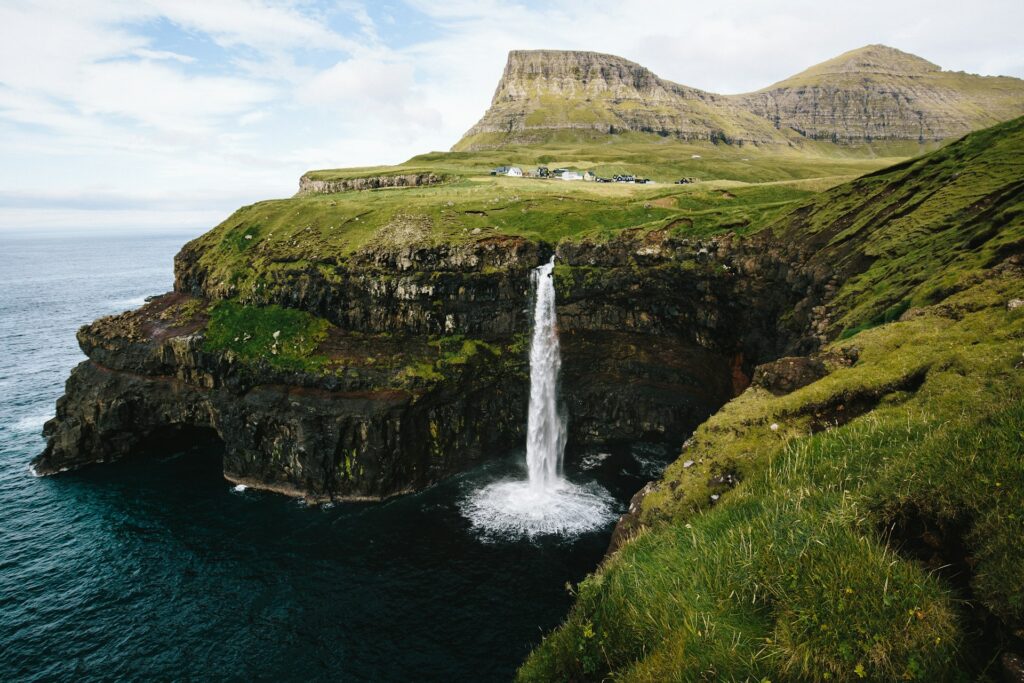
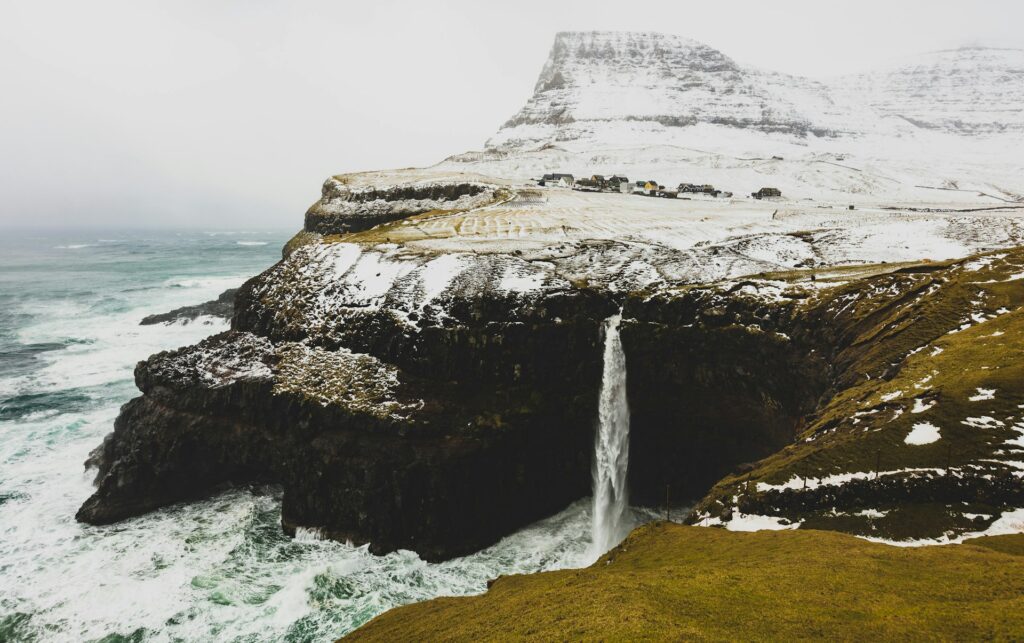
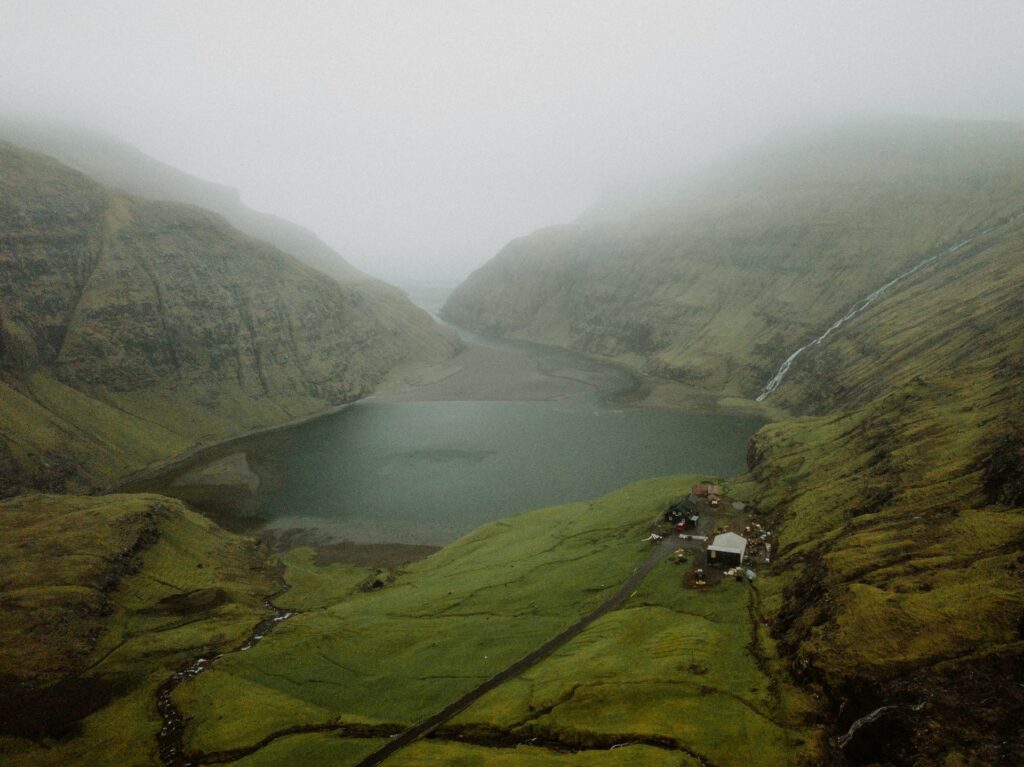
Winter visitors will find a more authentic, less touristy experience. Many locals consider this the most beautiful season, when waterfalls swell to their mightiest, the North Atlantic pounds relentlessly against the cliffs, and the traditional Faroese hygge (though they don’t call it that) comes alive with communal gatherings centered around food, music, and storytelling. Some attractions and restaurants may operate on reduced hours, but accommodations often offer lower rates, and you’ll have many spectacular vistas entirely to yourself.
Be aware that winter travel requires more planning – internal flights and ferries may be delayed or cancelled due to weather, and some hiking trails become dangerous or inaccessible. Pack proper cold-weather gear, including waterproof everything, and embrace the elemental nature of these remarkable islands at their most untamed.
Faroese Cuisine
The Faroese diet is deeply connected to the land and sea, shaped by centuries of isolation and challenging environmental conditions. In this harsh North Atlantic climate where little grows naturally, preservation techniques became essential for survival, leading to the traditional fermentation methods that define traditional Faroese cooking. This necessity-driven approach has evolved into a unique culinary heritage that continues to influence contemporary dining across the islands.
Most things you eat come from the sea – except lots of lamb. Skerpikjøt, a leg of wind-dried, aged and fermented lamb, often takes centre stage when guests come to visit and is considered the Faroe Islands’ great sustaining delicacy.
Nearly every Faroese home has a hjallur which is a drying shed). Built on sturdy stone or concrete foundations, the structure features walls made of wooden slats deliberately spaced a finger’s width apart, allowing the wind to freely flow through the gaps. It’s worth seeking out a course where you can have a go at salting and drying fish yourself to better understand the food of the Faroe Islands.
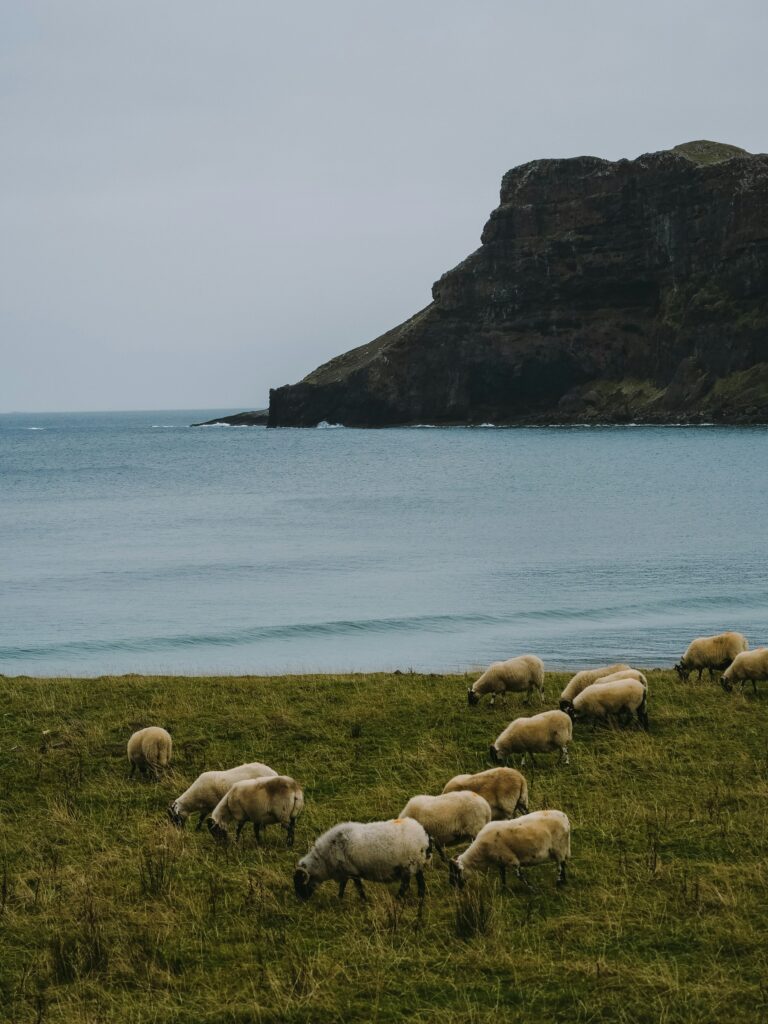
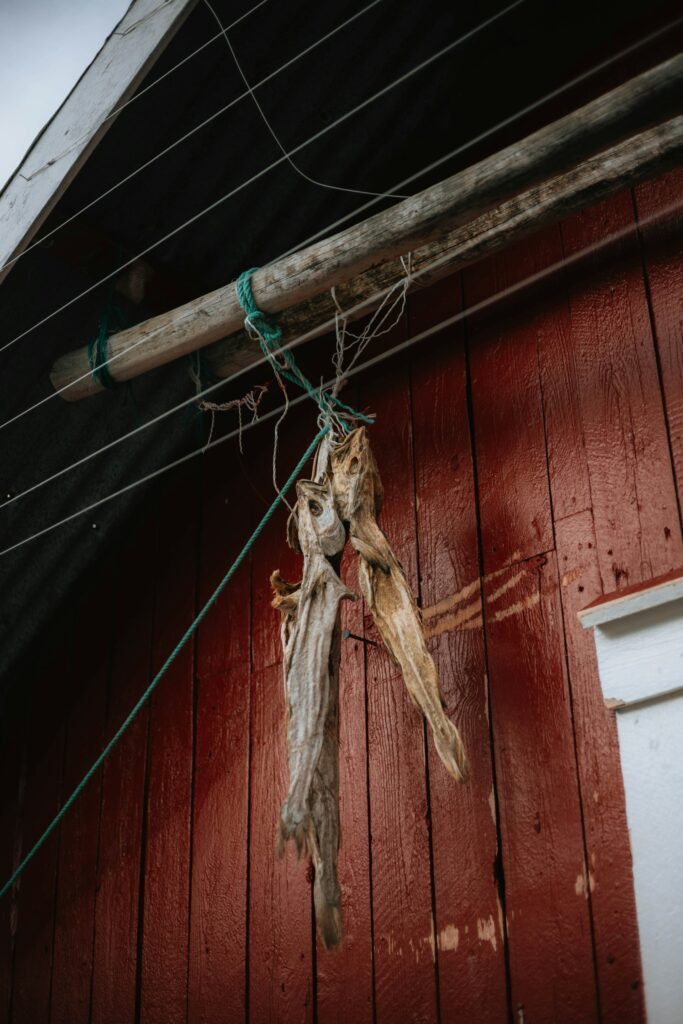
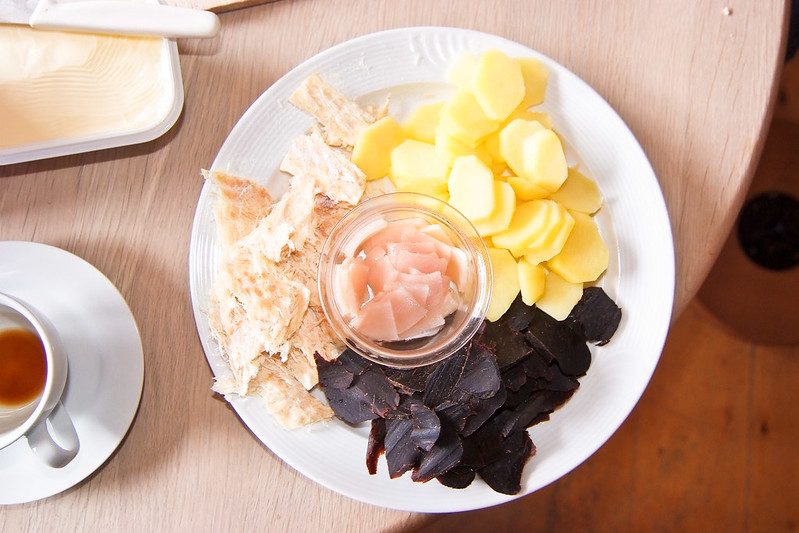
Beyond skerpikjøt, first-time visitors should sample several other traditional delicacies. Ræstur fiskur (fermented fish) has a distinctively pungent flavour that locals adore—it’s typically served with blubber and potatoes. Garnatálg is a unique dish made from sheep tallow and intestines, often spread on bread or served with dried fish.
For something more approachable, try freshly caught langoustine or the delicious Faroese salmon, widely considered some of the best in the world due to the pristine waters in which they’re raised. Don’t miss sýra, a fermented milk product similar to yoghurt that has sustained Faroese people for centuries, or the traditional rhubarb compote that provides a rare touch of homegrown fruit to the islanders’ diet.
While there are ongoing protests against the practice, grindahvalur (whale meat) does appear on menus in Tórshavn and other locations. The controversial grindadráp (whale hunt) remains part of Faroese tradition, though it’s increasingly debated both locally and internationally.
Modern interpretations of these traditional ingredients can be found in the new Nordic cuisine of high-end restaurants across the islands, where chefs are reimagining their culinary heritage with contemporary techniques. Which brings us to our next point…
Must-Book Restaurants: Ræst & ROKS
Both featured in the Michelin guide, there are two must-visit restaurants in the Faroe Islands. Ræst has earned international acclaim for its innovative approach to traditional fermentation techniques.
The restaurant’s name itself means ‘fermented’ in Faroese, and the menu showcases the unique flavours of properly aged local ingredients. Dining at Ræst is not just a meal but a cultural expedition—each dish tells a story of Faroese heritage and survival in this unforgiving landscape. The intimate dining room, with its minimalist Nordic design and panoramic windows overlooking Tórshavn’s harbour, creates an atmosphere that perfectly complements the bold flavours on your plate.
ROKS, the sister restaurant to the two-Michelin-starred KOKS offers a more accessible but equally impressive dining experience, highlighting the extraordinary bounty of Faroese seas and pastures. Chef Poul Andrias Ziska’s visionary approach transforms the most humble local ingredients into sublime culinary creations. The tasting menu changes with the seasons and might include anything from langoustine with fermented blueberries to lamb heart with crowberry sauce. What makes ROKS especially compelling is its commitment to sustainability and its deep connection to place — every ingredient has a purpose and a story, often harvested or foraged from the surrounding landscape just hours before service.
Both restaurants offer diners a rare opportunity to taste the essence of the Faroe Islands through the lens of contemporary Nordic cuisine. They represent the archipelago’s emergence as an unexpected gastronomic destination, where isolation has fostered creativity rather than limitation. While expensive, these dining experiences offer value far beyond the food itself—they provide insight into Faroese culture, history, and innovation that you simply cannot gain elsewhere.
Booking well in advance is essential for both establishments, particularly during the summer tourist season. Reservations can be made up to three months ahead and tend to fill quickly.
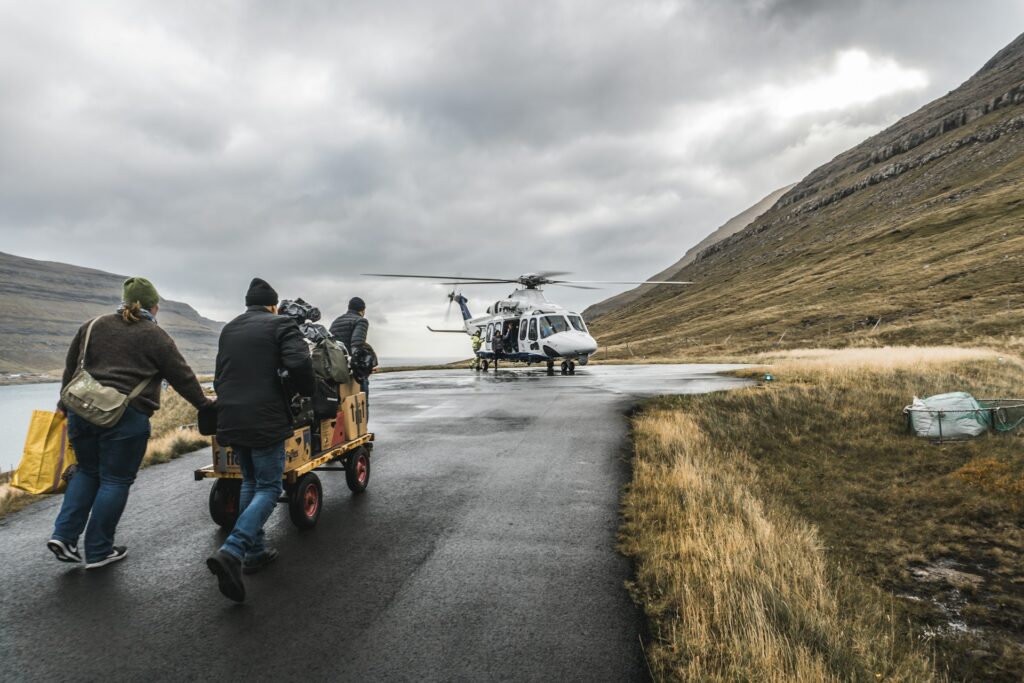

Helicopters Are Like Buses
In most places, helicopter rides are reserved for the rich and famous. However, on the Faroe Islands, they serve as a legitimate form of public transportation. That said, it might be prudent to book your own private flight if you’re short on time and keen to personalise the experience as much as possible.
One of the best experiences when booking a helicopter charter is flying to Suðuroy, the southernmost island in the Faroes. Seeing the stunning archipelago from a bird’s eye view is something else entirely – unfathomable cliffs and precipices with adventurous sheep and lambs grazing precariously, puffin burrows dotting the landscape, and circling fulmars riding the thermals.
Vikings & Visiting Ancient Historic Sites
The Faroe Islands’ rich history extends back to Norse settlement in the 9th century, and evidence of this Viking heritage is scattered throughout the islands.
Popular ancient historic sites to visit include the Viking settlement at Kvívík, where you can see the remains of a longhouse and barn dating back to the 10th century. The village of Kirkjubøur is home to the ruins of St. Magnus Cathedral, the medieval Bishop’s residence (Kirkjubøargarður), and the still-functioning St. Olav’s Church, which dates from the 12th century.
For a better understanding of the islands, be sure to visit the Faroe Islands National Museum. In the summer months, there is an open-air museum which presents life as it was a century ago, with traditional buildings and demonstrations of historical crafts and farming techniques.
Ideal Tip: While not exactly an ancient historic site, film buffs should make a special trip to Kalsoy island. The dramatic cliffside location served as the finale setting in the 2021 film “No Time To Die” and local authorities have installed a memorial stone that has quickly become a popular pilgrimage spot for 007 fans.
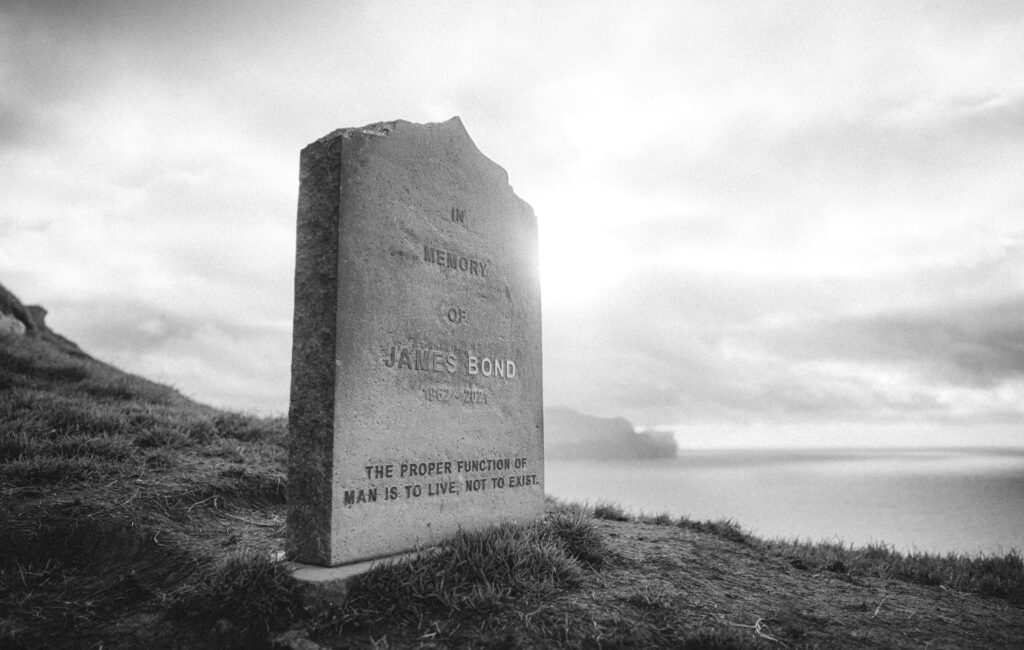
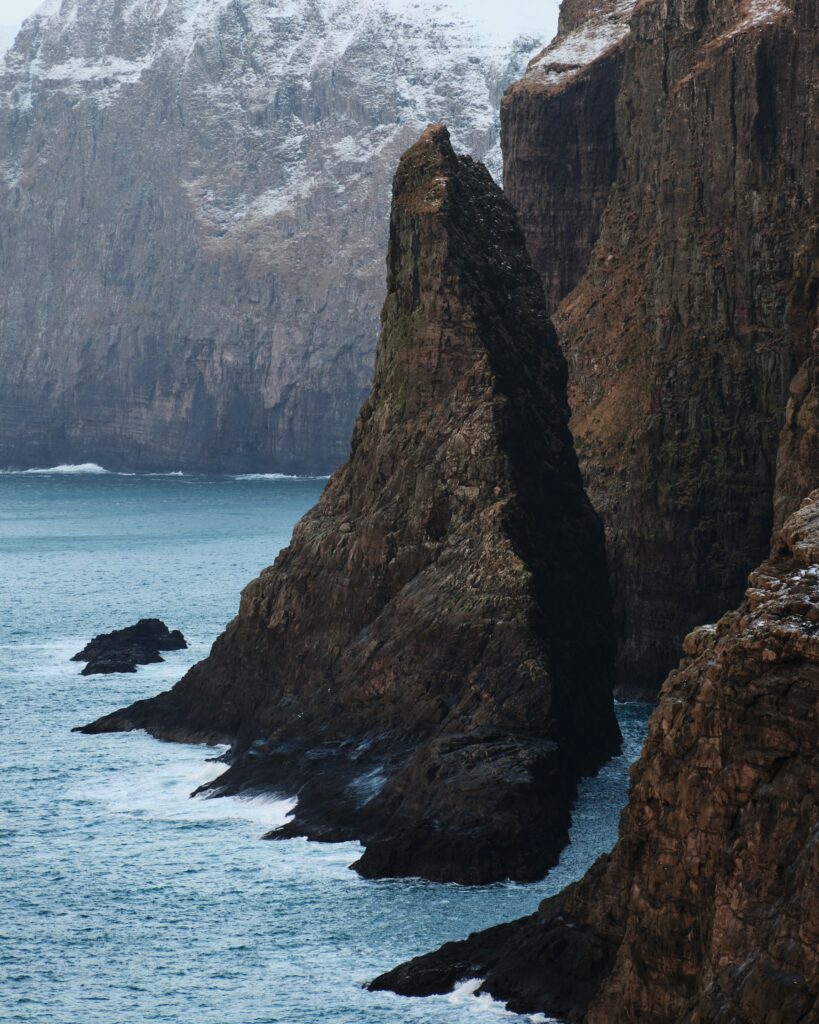
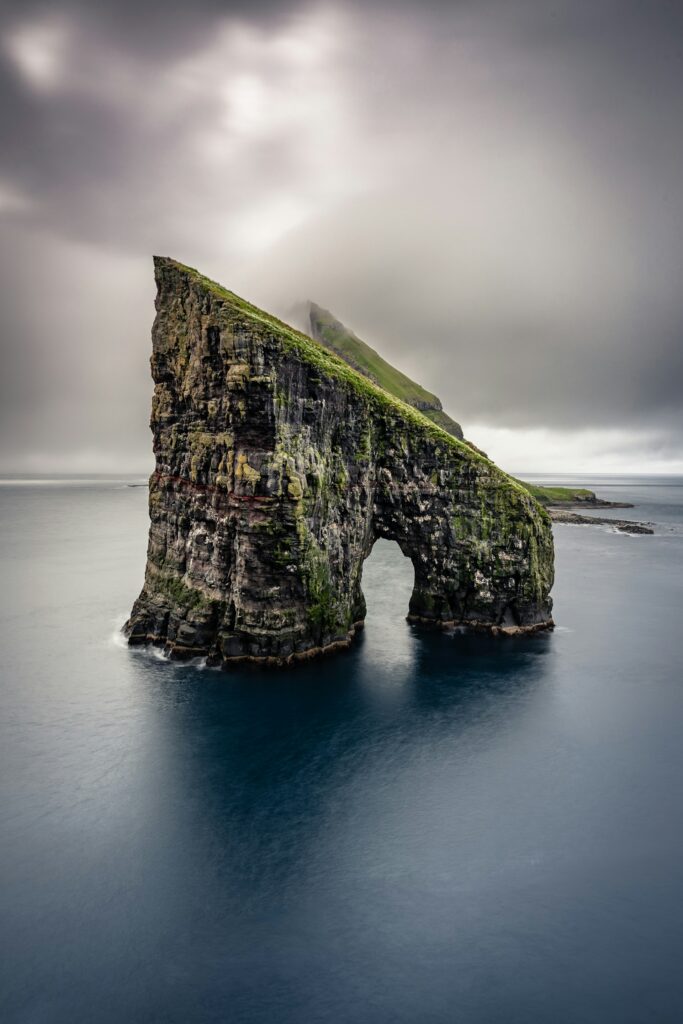
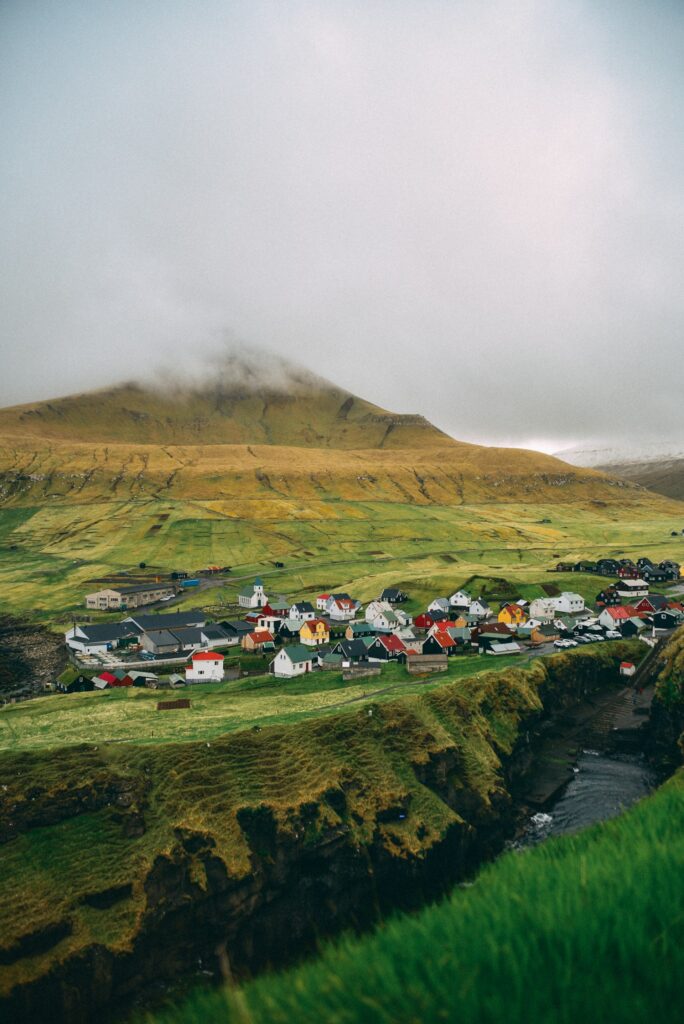
See The Islands by Sea
The dramatic coastlines of the Faroe Islands are best appreciated from the water. Setting sail in a traditional Faroese wooden fishing boat offers a unique perspective on the towering sea cliffs and hidden caves that characterise the archipelago.
Various operators offer boat trips around the islands, with popular routes including the bird cliffs of Vestmanna on Streymoy and the dramatic Tindhólmur islet with its distinctive peaked landscape. These excursions often include close encounters with seabirds, seals, and occasionally dolphins or whales.
Island Hopping
Getting between islands is surprisingly straightforward thanks to the Faroes’ impressive infrastructure. The islands are connected by an extensive network of tunnels, bridges, and ferries, making island hopping relatively easy.
The Faroe Islands are home to state-of-the-art undersea tunnels connecting the islands, making it easy to hop between islands. One in particular is a tourist attraction itself and has become quite the draw for holiday makers. Located 72m below the surface and home to the world’s first underwater roundabout, the Eysturoyartunnil is the world’s first underwater roundabout and features artwork and a sculpture by Faroese artist Tróndur Patursson.
For the more remote islands, ferry services are available. The Strandfaraskip Landsins route to the southern island of Suðuroy is one of the most important connections, offering a scenic 2-hour journey through open waters.
While you can get around by public transport, it’s best to hire a car if you can. Weaving in and out of the island’s long tunnels beneath the sea at your own leisure is a unique experience in itself. Moreover, driving is very relaxed, with minimal traffic – there are only five sets of traffic lights in the whole country!
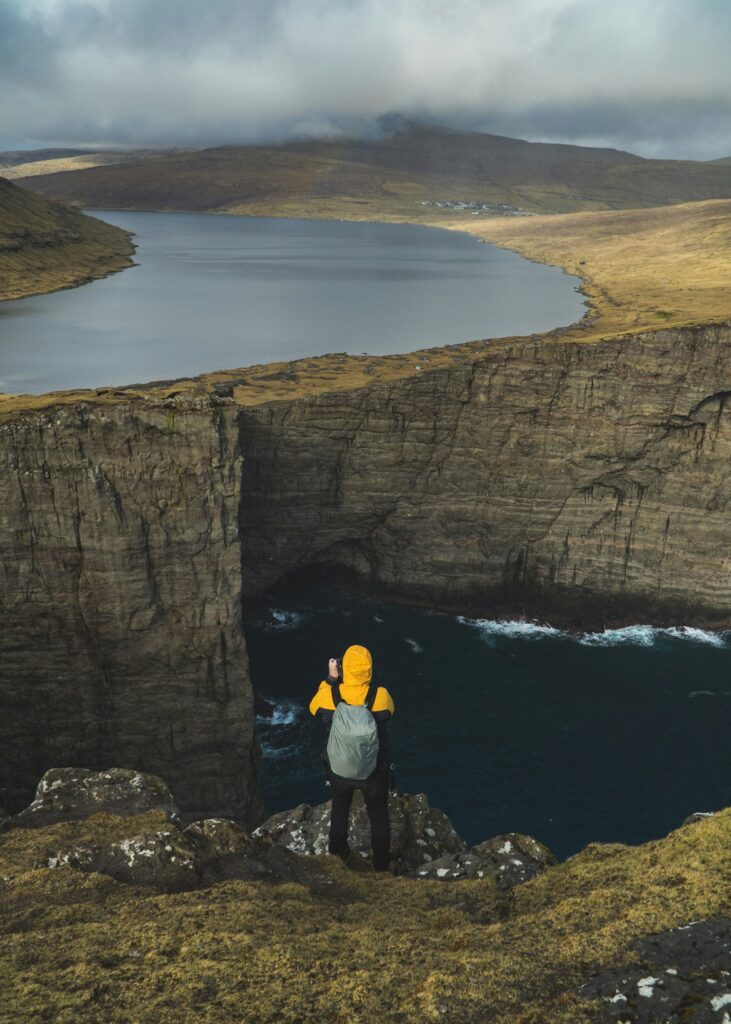
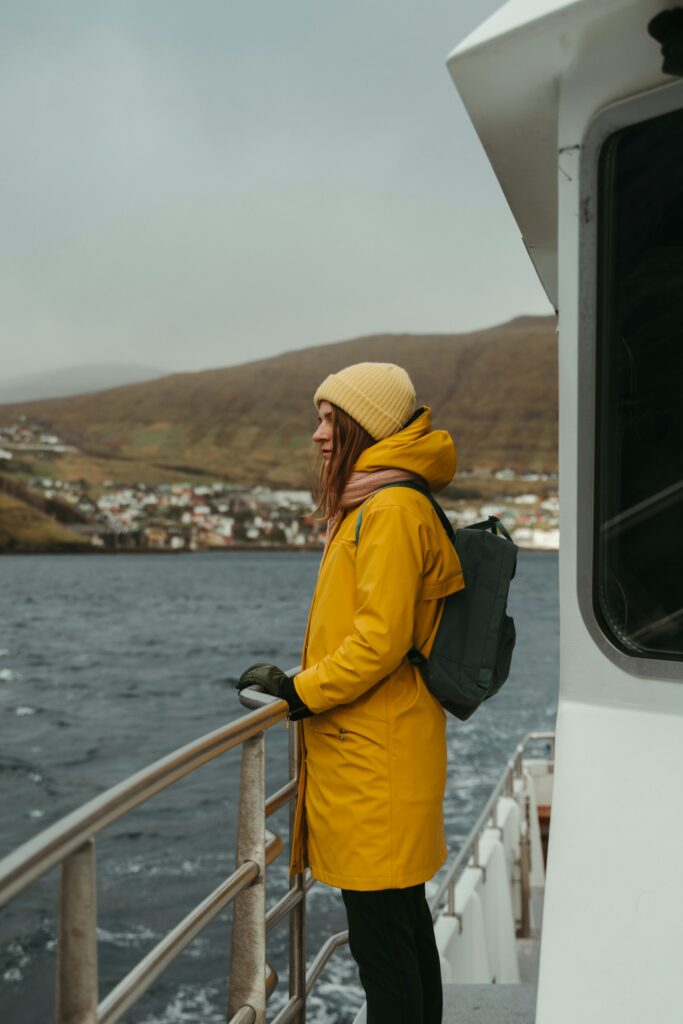

Book A Homestay
If you’re looking for an indulgent stay, then consider the four-star Hotel Føroyar in the Faroese capital of Tórshavn, with its stunning views over the city and immediately-identifiable turf roof that blends into the hillside.
However, a unique way to experience the islands and get a glimpse into how the people of the Faroe Islands live is to book a homestay. Several platforms offer accommodation in local homes, providing not just a place to sleep but an opportunity to connect with residents and learn about Faroese culture firsthand.
Many homestays are in picturesque villages off the typical tourist route, offering authentic experiences and often home-cooked meals featuring local specialities.
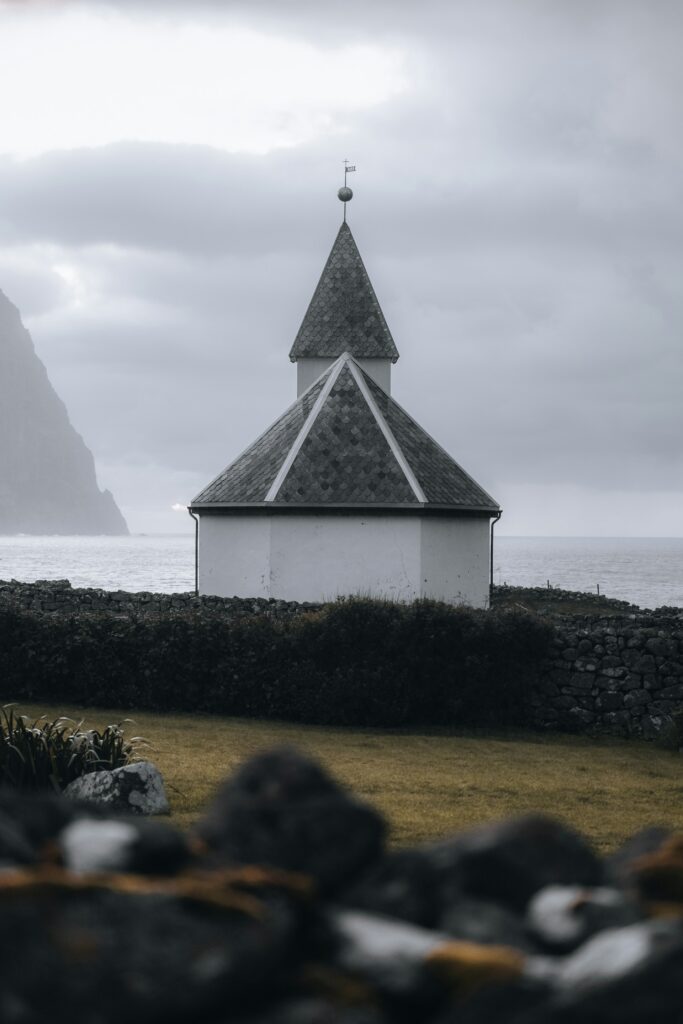
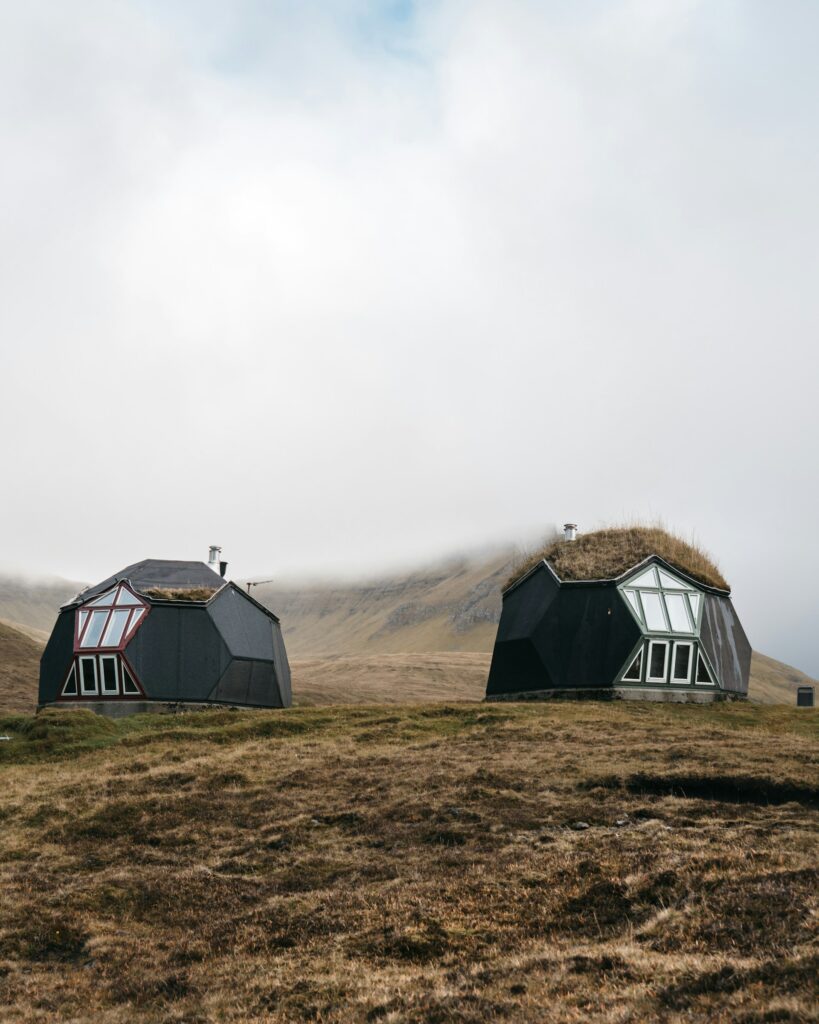
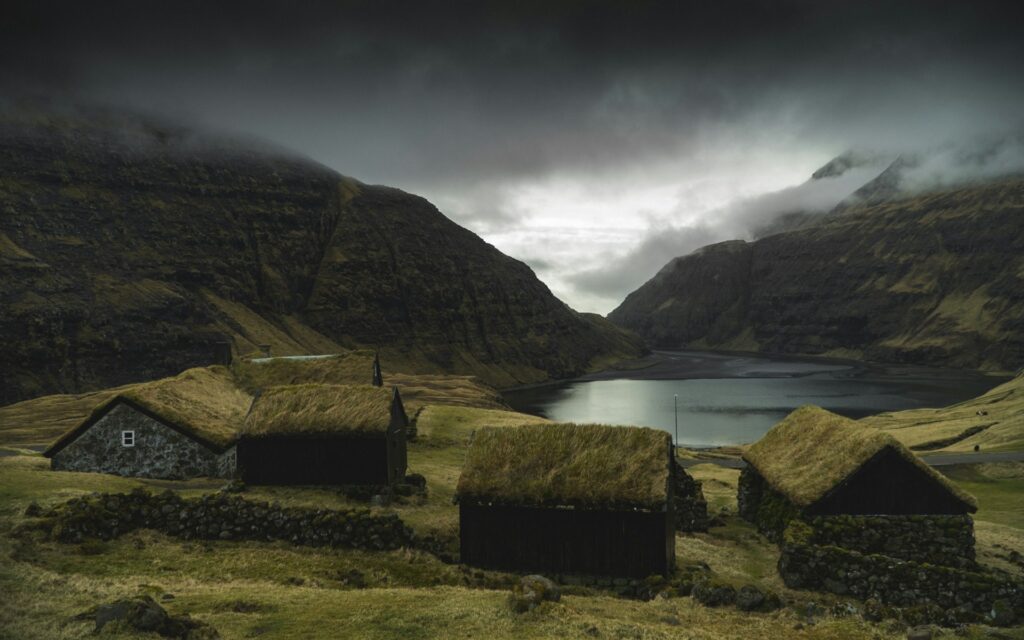
Early Morning Flights
If you’re catching an early flight out, or arriving late, consider staying near the airport. The island’s airport hotel, Hotel Vágar, has recently reopened following renovations. It’s a great place to stay before those early morning flights, eliminating the stress of pre-dawn drives across the islands.
The hotel also offers stunning views over Sørvágsfjørður and is conveniently located for exploring the western part of Vágar, including the famous Múlafossur waterfall in Gásadalur.
Bring Hiking Gear
The Faroe Islands are a hiker’s paradise, but the terrain demands proper equipment. You’ll want to visit places like Fossa in Streymoy, which is the tallest waterfall in the Faroe Islands. The waterfall impressively cascades in two distinct tiers between dramatic dark basalt cliff walls. While the terrain is rocky and demanding, the effort is absolutely worthwhile. The powerful, continuous rush of water creates an awe-inspiring and thunderous experience.
Another spectacular trail that draws adventurous hikers is the path to Kallur Lighthouse on Kalsoy Island, often called ‘the flute’ due to its long, narrow shape and tunnel-filled road. The hike begins in the tiny village of Trøllanes (population: 15) and winds along dramatic clifftops to the iconic red and white lighthouse perched precariously on the northernmost tip of the island.
What makes this hike truly special is the heart-stopping view from the ridgeline near the lighthouse—a knife-edge promontory with vertiginous drops on three sides, offering arguably the most photographed vista in all the Faroes. Those who brave the sometimes muddy and always wind-battered path are rewarded with panoramic views of Kunoy, Viðoy, and on clear days, all the way to Fugloy, the Faroes’ easternmost outpost. The return journey takes about 3-4 hours in total, but allow extra time for the ferry to and from Kalsoy, which runs only a few times daily.
Visiting such places requires being prepared for a challenging hike with some difficult sections that demand careful navigation. Be sure to invest in some quality hiking gear, including waterproof boots with good ankle support, layers of weather-appropriate clothing, and a reliable waterproof jacket. The weather can change rapidly, and being properly equipped is essential for both comfort and safety.
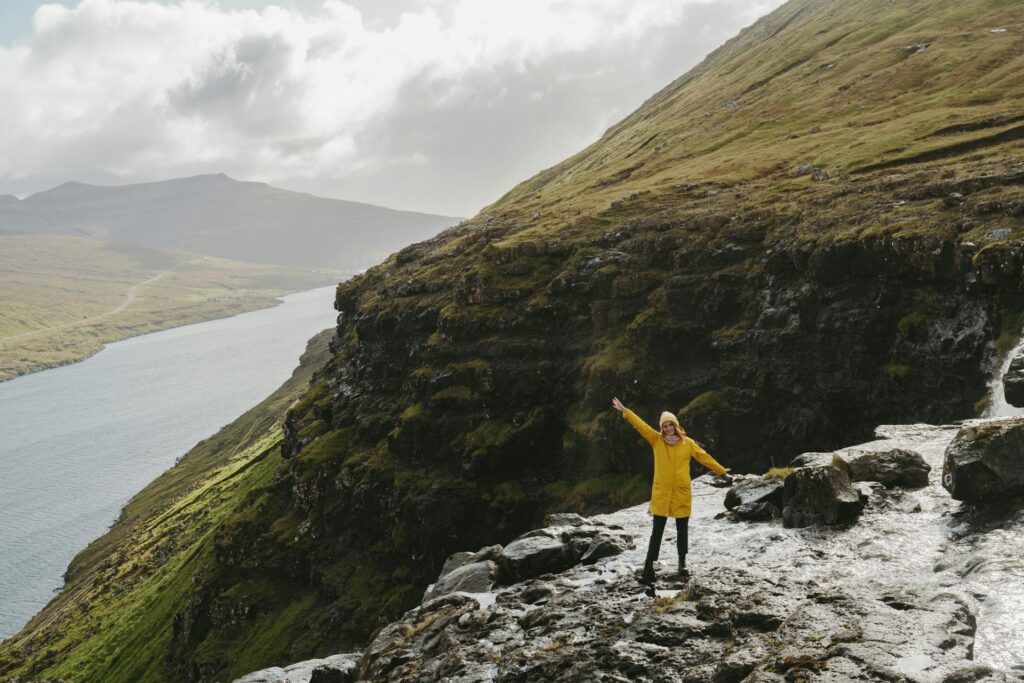

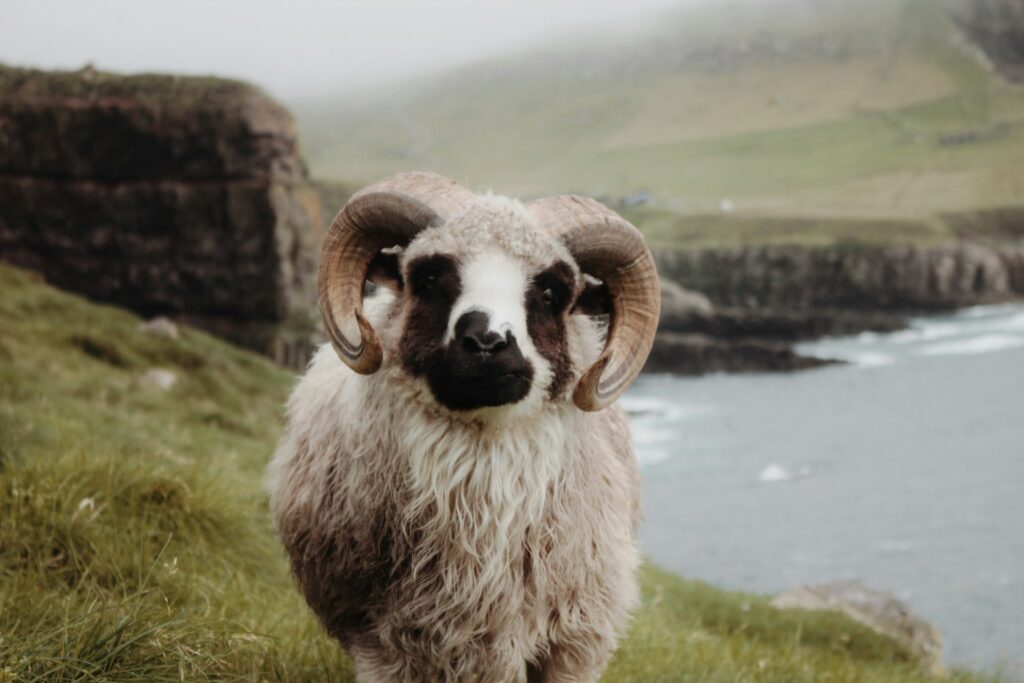
Surfing & Scuba Diving
The Faroe Islands might not be the first destination that comes to mind for water sports, but the archipelago offers some exceptional opportunities for the adventurous.
For surfing enthusiasts, the islands’ exposure to North Atlantic swells creates consistent waves, particularly during winter months. You’ll need a wetsuit, even in summer, as water temperatures rarely exceed 10°C (50°F). The islands have big swells and attract experienced surfers from around the world.
Scuba diving in the clear, cold waters around the Faroes reveals vibrant marine ecosystems and fascinating underwater landscapes. Several dive operators offer guided excursions, with a dive school providing certification courses for beginners. The underwater visibility can be exceptional, offering glimpses of colourful marine life against a backdrop of dramatic submarine geology.
Preparing For Puffins
One of the most popular hikes is on Mykines, leading to the old lighthouse. Mykines is one of the Faroe Islands’ greatest attractions, famous for its abundant birdlife. Here you’ll find colonies of puffins and northern gannets nesting near the paths, creating incredible opportunities for wildlife photography. The Atlantic puffin (Fratercula arctica) is particularly drawn to the Faroe Islands due to the archipelago’s perfect combination of ecological factors.
The islands’ steep, grassy sea cliffs provide ideal burrowing sites where puffins can dig their nesting tunnels safe from most predators. The surrounding cold, nutrient-rich waters of the North Atlantic support abundant populations of small fish—particularly sand eels, capelin, and herring—that make up the puffins’ primary diet. The isolated nature of the Faroes also historically meant fewer land predators, creating a relatively safe haven for these charismatic seabirds.
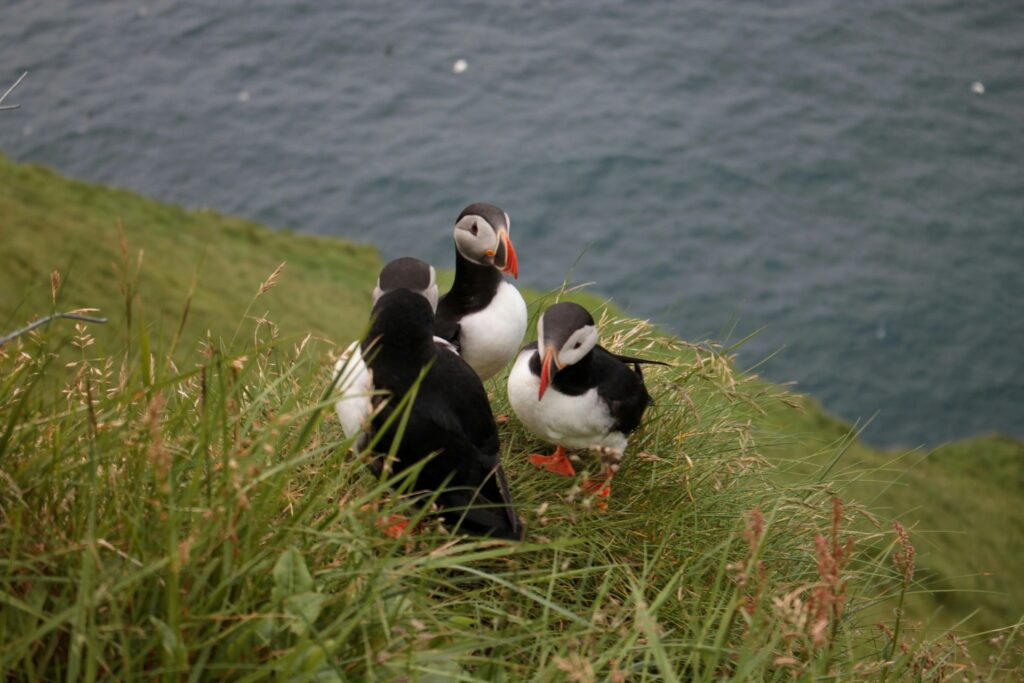


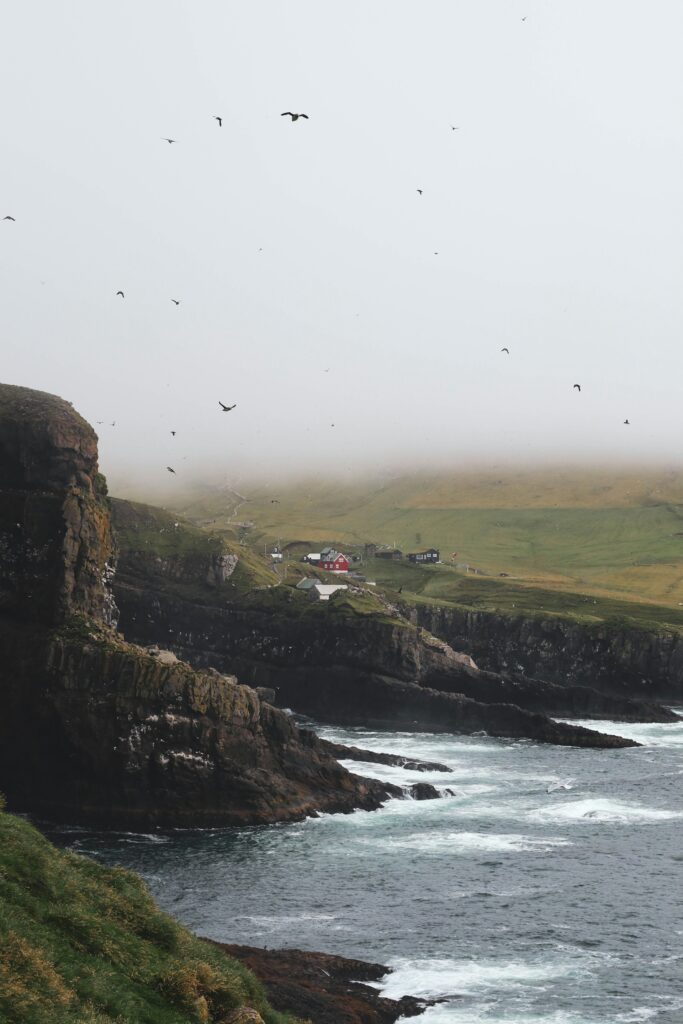
Mykines hosts around 125,000 breeding pairs of puffins each summer, transforming the western island into a bustling avian metropolis. These ‘clowns of the sea’ with their distinctive colourful beaks spend most of their lives on the open ocean, coming to land only during breeding season. The puffins’ return to the Faroes each spring marks a celebrated natural event, as they arrive with remarkable navigational precision to the same nesting sites year after year.
Be aware that there’s a strict cap on the number of visitors in the summer to protect the fragile ecosystem. If you want to come here, book ahead through the official website to secure your spot and the required guide. These restrictions are essential, as puffin populations have been declining across the North Atlantic, making conservation efforts on the Faroes increasingly important.
The best time to see puffins is from May to August, with peak season in June and July when parents are busy feeding their single puffling (baby puffin). Morning and evening visits often yield the best sightings, as the birds are most active during these times. Bring a good zoom lens for your camera, but remember to maintain a respectful distance from the birds. Puffins may look adorably approachable, but human disturbance can cause them to abandon nests or drop precious fish intended for their young.
Alcohol Laws Are Very Different Here
The Faroe Islands has a complicated relationship with alcohol due to a time where many people on the islands suffered from alcohol abuse. Production of alcohol was illegal as recently as 2012, and sales remain tightly controlled. You can only buy alcohol from state-run outlets or in bars and restaurants.
The main liquor store chain, Rúsdrekkasøla Landsins, has limited locations and opening hours, so plan accordingly if you want to purchase alcohol. Prices are high compared to mainland Europe, reflecting both import costs and taxation policies.
While beer is undoubtedly popular, the Faroese have a particular fondness for aquavit (locally called ‘akvavit’), a distilled spirit flavoured with caraway or dill. This potent Scandinavian tradition has been embraced in the Faroes, where it’s often enjoyed as a warming shot alongside seafood dishes or during festive gatherings. Locals typically serve it chilled and sip it slowly, following each taste with a small bite of food. For the authentic experience, try it alongside traditional Faroese fare like dried fish or fermented lamb. You’ll find both imported varieties from Denmark and Sweden, as well as newer, locally produced options featuring Faroese botanicals.
In recent years, a nascent craft beer scene has emerged, with microbreweries like Okkara and Føroya Bjór producing unique local brews worth sampling during your visit. Føroya Bjór’s Gull pilsner is particularly ubiquitous across the islands and represents a point of national pride among many islanders.
Don’t Forget A Souvenir

If you want to blend in, buy a jumper. Indeed, Faroese culture appreciates good knitwear, and the islands are renowned for their rare wool products. Local knitwear company Gudrun & Gudrun are behind those famous jumpers worn in the Danish drama Forbrydelsen (The Killing), which brought international attention to Faroese design.
Traditional Faroese sweaters (Føroysk troyggja) feature patterns that often tell stories or represent aspects of island life. While not inexpensive, these handcrafted woollen garments are made to last generations and make for meaningful souvenirs that capture the essence of this remote archipelago.
Other authentic souvenirs include socks, local art, music recordings of traditional Faroese ballads, and food products like salt made from evaporated seawater or small-batch spirits from the islands’ new distilleries.
The Bottom Line
The Faroes are islands of great charm, offering an increasingly rare combination of pristine natural beauty, rich cultural heritage, and modern infrastructure. While they may require more effort to reach than more mainstream destinations, the rewards for intrepid travellers are immense.
These windswept islands in the North Atlantic provide an opportunity to disconnect from the frenetic pace of contemporary life and connect with a simpler, more elemental way of being. Whether you’re hiking along vertiginous sea cliffs, sampling fermented delicacies, or simply watching the play of light and shadow across the mountainous landscape, the Faroe Islands offer experiences that linger in memory long after you’ve returned home.


